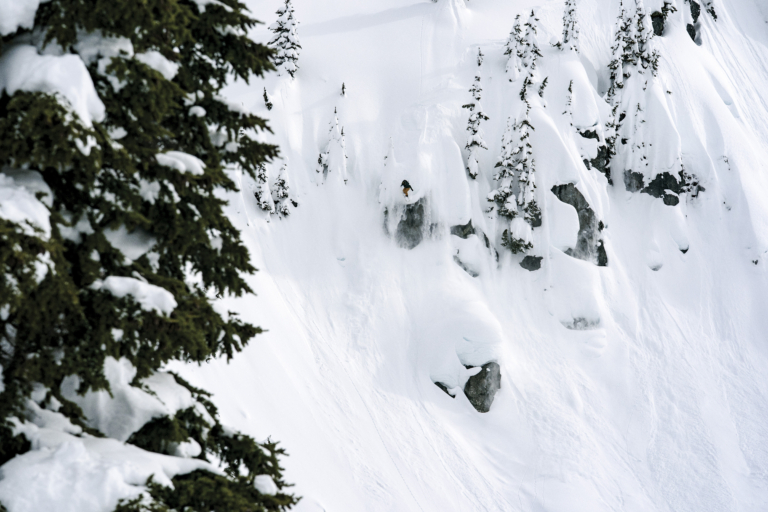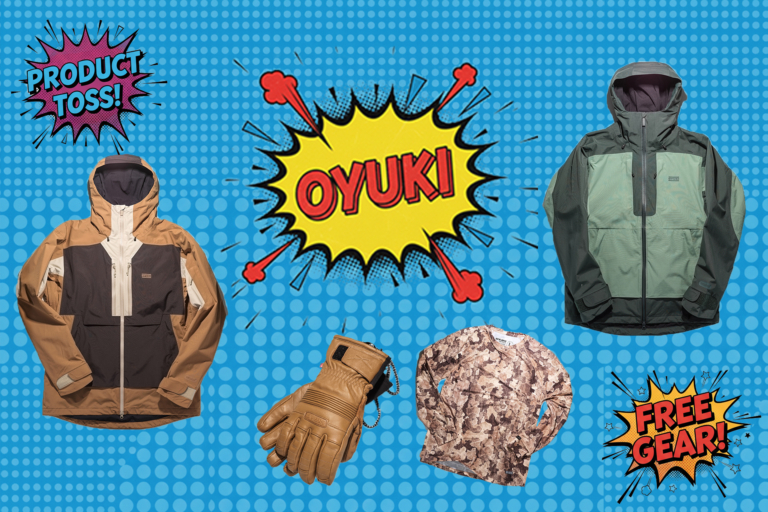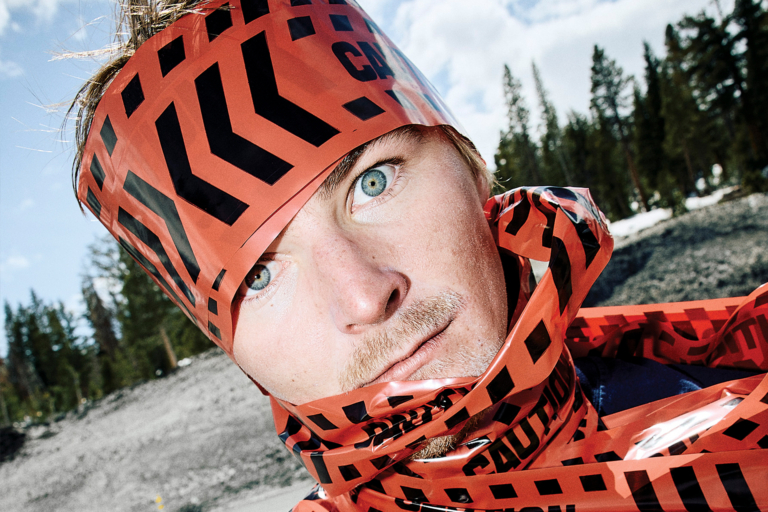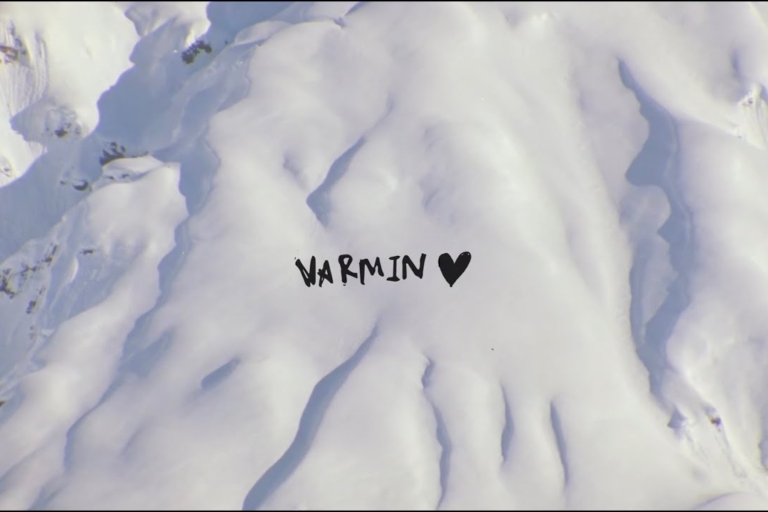A true product of the Canadian Rockies, Joey Vosburgh spent his youth burning laps at pivotal local resorts Lake Louise, Sunshine Village, and the now defunct Fortress Mountain. When the resort wasn’t enough, Joey and his crew found their way into the Lake Louise sidecountry–now a permanent extension of the resort–to get their turns. Bootpacking led to snowshoeing, and by the mid-90’s Joey was riding a DIY splitboard, unknowingly paving a path forward to his future career as an Association of Canadian Mountain Guides (ACMG) certified splitboard guide.
With his feet planted firmly in the roots of the sport, Joey has evolved to scale things back and simplify what’s out there for those that learn from him. He is focused on what really matters and how to approach the backcountry with intention and clarity. Joey will be imparting knowledge and instilling community at the upcoming Arc’teryx Backcountry Academy in Mammoth Lakes with his clinics Split Ski Extravaganza Day, and Avalanche Safety – What Really Matters.
I caught up with Joey to talk shop on his approach to the backcountry, mentorship, and well, what really matters.

Hey Joey, how’s your winter going?
Kind of standard operating practice for me. I just work kind of endlessly and on my days off, I get out as much as I can. These days off are much needed, I think I did 22 days on snow there.
Damn, that’s the guide’s life I guess. Why don’t you give me a quick intro on how you got started splitboarding, growing up in the Rockies and being one of the early adopters of the split.
Well, I started snowboarding in ‘88.
It was like right at the the cusp of the Calgary Olympics. I was a skier up until then, and I was also a skateboarder. One of my earlier memories was seeing a snowboarder going under the ski lifts at Fortress Mountain and I was like, I gotta do that, I’m a skateboarder, why am I on these two things?
I got my mom to buy me a board and that was that. So, Fortress Mountain has this kind of old snowboard culture with a windblown halfpipe and drifts and a very surfy style to it, and it just grasped me. From there, I went towards Lake Louise and Sunshine Village, and of course, we all wanted to go into the backcountry and slackcountry, which at the time wasn’t really a term. It was kind of sketchy off Lake Louise off the Westbowl and Pipestone area. We were going out there with solid boards and then boot packing out and doing big long traverses. Slowly, that just turned into snowshoes. That lasted for a handful of years before the splitboard came on our radars.
My first splitboard was just a cut board with the Voile DIY kit.
I did that for quite a few years until probably like ‘94 or ’95. I got my first legit splitboard that was made from the factory, a Burton S-Series and yeah, here I am.
How was the process of becoming a full ski guide with the ACMG?
Guiding was never on my radar. The avalanche courses I took were courses that I convinced my mom to let me take with my education money that she was saving for me to go to university. I was like, I’m not going to university, mom, it’s not my not my thing. I wanted to know more. I didn’t wanna die. When I did my Canadian Avalanche Association (CAA) course, I couldn’t afford the hotel, so I dug into one of the snow banks at Rogers Pass. I lived in the snow cave and did the CAA Level One. Guiding didn’t mean anything to me. Snowboarding wasn’t really allowed in the ACMG at the time. I was just recreating heavily. I moved to Revelstoke in 2005, and got linked with a really tight ski touring crew and none of them were splitboarders. They were legend ski mountaineers and we were summiting mountains and skiing lines and I was learning how to keep up with the skiers, and how to adapt my technique and my gear. Guiding came as a by-product of that. I saw heliskiing and I saw ski touring guiding, and I was like holy shit, people make a living doing that? The ACMG wasn’t really accepting snowboarders and Scott Newsome was kind of battling through it, he’s a good friend of mine so, I kept my finger on the pulse of what he was up to, and when he got through, the ACMG opened it up for snowboarders and I was in. They had no extra skills or anything, they were just like, “you need to provide the same product that a ski guide would, but as a snowboarder”.By 2014, I was a full ski guide. It’s really hilarious because my certificate says: ACMG Ski Guide (on a snowboard).

Haha, of course.
I think they changed that now, but that being said, I firmly believe that I am a ski guide that chooses to ride a snowboard. It doesn’t really matter what I ride.
I think that’s a good perspective because it often gets kind of segregated as two totally different things and it doesn’t have to be.
It’s not, I guide 95% skiers, and a lot of them are really good. With Selkirk Tangiers, I’m one of their senior lead guides and I have a lot of groups that are fast and expect me to keep the flow going and that’s all part of the skill development.
You kind of alluded to this, but over the years and throughout your career, how would you say avalanche education has evolved over that time?
I think it’s evolved in a way that they’re now learning that the most important things aren’t necessarily the snow crystals and looking through things in a microscope and all the little acronyms and stuff. I’m happy to see a lot of the AST level one and two courses are really more focused on terrain and decision making. Human factors are such a big part of accidents that, you know, just because you know what crystal is under your feet and how big that crystal is, doesn’t mean you’re not going to have an accident.
If you’ve got really poor communication skills and really poor team management and no awareness of human factors, you can get in trouble pretty easily. I do still see a lot of focus on results, like digging pits and stuff like that, those are all really good ways to gather data and create a paper trail within an operation, whether your operation is your own personal guiding or whether your operation is working for a big heliski company, you do want to gather concrete evidence that kind of corroborates your desire to step out in the train and do more interesting objectives.
I also really have a hard time when I see a lot of pit digging, it’s all really good stuff. But it doesn’t answer the question, “will this avalanche if I ski it?”.

Yeah, totally. Growing on that, how would you say that access to knowledge, education, and mentorship has changed?
I feel like that is one of the most significant things.The culture has changed. It used to kind of be this like black magic, you know, and no one wanted to share how they navigated the dangerous mountains. They just wanted to keep that to themselves and look like a magician out there. It’s become a really sharing culture.
Of course, the Arc’teryx Backcountry Academy is just the premiere of that kind of course level stuff. All the athletes who come out, are in my mind, guides. They have stayed alive and made some great decisions their whole lives. If anything, The ability to go out with a guided team at the academies and have that expertise from athletes and guides is really cool.
Even in my courses, I have changed the way I want to teach. When I first started doing the academy down in Jackson Hole, WY, I was doing advanced splitboard mountaineering and that’s who I identify as. The more I did them, the more I recognized that the best way to teach was to focus my clinics on the skill development and intermediate side of things. You really see the light go off in people’s eyes at the intermediate level. It’s a “what really matters?” kind of mindset.
On that note, I’d love to hear your perspective or advice for people making the transition into backcountry riding and splitboarding, getting educated and what kind of opportunities you see are available for people.
Well, I mean, there’s always the structured classroom style AST or AIARE courses and those are great. That’s what I started doing, I needed to be shown what terrain was dangerous and what wasn’t.
I would definitely recommend everyone do some sort of education, and even find a guide that doesn’t necessarily just want to guide and shut up and take you to the top, but someone who wants to to talk about the process, right? That’s the most important thing: the process of the decision making. How do you decide when it’s time to turn around? It’s a tricky gray area, and in my experience, it’s not necessarily at the valley bottom or just before I trigger an avalanche, it’s somewhere in the middle. It all depends on the terrain and the information you are gathering through observations. That’s what dictates the decision making moment.
I feel like most of my most memorable and important education moments have been out in the field with a mentor or a friend, making a decision together.
I was so lucky I fell in with this crew of ski tourers when I moved to Revelstoke. They were all either guides or becoming guides and they just taught me stuff. It wasn’t like a grasshopper moment, but more about coming home safe together. Just friends going ski touring and having a conversation. If you have one person always making the decisions, that’s a really dangerous place to be in. It doesn’t have to be a touchy, feely discussion either, it can just be like, oh fuck, I’m scared, I don’t like this. It’s simple, and hopefully everyone in the group recognizes that maybe they aren’t seeing it, or maybe the group needs to slow down and talk.
How do you see that community aspect play out in backcountry riding and what kind of tips do you have for people to go out and build their own community, especially with the upcoming Arc’teryx Backcountry Academy in Mammoth Lakes?
I mean, I just think the Arc’teryx Academies are incredible because everyone gets together and sure, there’s the in-the-field stuff, but there’s also the après stuff that’s just invaluable. I think you get to kind of align yourself with who might be at your skill level, or even your risk tolerance level. Everyone’s got a varying level of risk tolerance and I think that it’s really important to figure out where you stand, and align yourself with similar people. For those who have just moved to a community or are new to the sport and don’t know many people, those moments of community gathering are really important. If you walk into an event and people are talking about doing gnarly shit and you’re just learning to skin, you can maybe find someone on your level. It’s really cool, everyone meets for the first time at some point.
You’ll be running two clinics at the Arc’teryx Backcountry Academy in Mammoth. One is a Split Ski Extravaganza Day, and one is an Avalanche Safety clinic called What Really Matters. Do you want to give a preview of what people can expect? The split skiing one is great, because a lot of people think it’s funny or silly, but it’s really valuable to be able to use your split well. I’ve seen some wacky split ski moments in the wild, and I want to hear your perspective.
Yeah, with the split skiing, it really depends on where you go, but mountains aren’t always perfectly built to just snowboard from the top to the bottom. You’ll find yourself in these weird kind of snowboard awkward moments where you can’t snowboard anymore because you’re at the bottom of the ditch or maybe you’re on the flat and all your buddies are cruising by you. I think getting good at split skiing without your skins on, is really important. You don’t have to ski gnarly, you just need to learn the balance point. It’s super valuable to spend some time on a ski hill and do some really bunny slope stuff. It isn’t necessarily down either, it’s sidestepping without heels, it’s freaking weird. It took me years to come up with techniques to help that. These little tips help people move a little smoother and give them confidence to switch back and forth. In my daily guiding, sometimes I’m splitting into skis like 10 or 20 times a day, and I have my little technique to keep the flow. It’s really important to gather, make the space for people to feel confident and learn comfortably.
Totally, I have so many memories of wasting time like, is it skins on, is it skins off, is it worth switching over?
Yeah, haha, that’s it. Jumping to my other clinic, I think in years past I focused on advanced splitboard mountaineering and it’s such a generalized term, it just means you’re going out for a day of snowboarding. Those are great courses, but I think the athletes can take the lead on that and take the torch off me. I wanted to come back to this “what matters” mentality. It takes us back to the talk about the pit results and how to relate that to avalanches, like what are the real observations and what am I trying to gather? I’ve got a process that simplifies a lot of the shit that’s out there and I really focus on that and do some scenarios that build some intensity and excitement and challenge decisions. I think that the more you practice in a kind of exciting situation with some intensity, it benefits you when the real thing does happen.
Any last words or advice for those that will be attending the Arc’Teryx Backcountry Academy in the spring?
I mean, just come out and check it out. Arc’teryx does a great job with the clinics. They do a great job with the programming and it’s such a fun time.
It’s the only time I take out of my guiding career or guiding season. The family of Arc’teryx is so awesome and they just do this really bang up job. I just look around and all I see is happy faces and people are stoked and there’s lots of other extracurricular things going on. I’m sure there’ll be just a really great showing of the backcountry community that everyone can kind of tune into. Just come with a happy face and positive attitude, and if you can get into one of the clinics, they are awesome, but if not, just come and and just soak up the community via osmosis. I’m looking forward to it.






